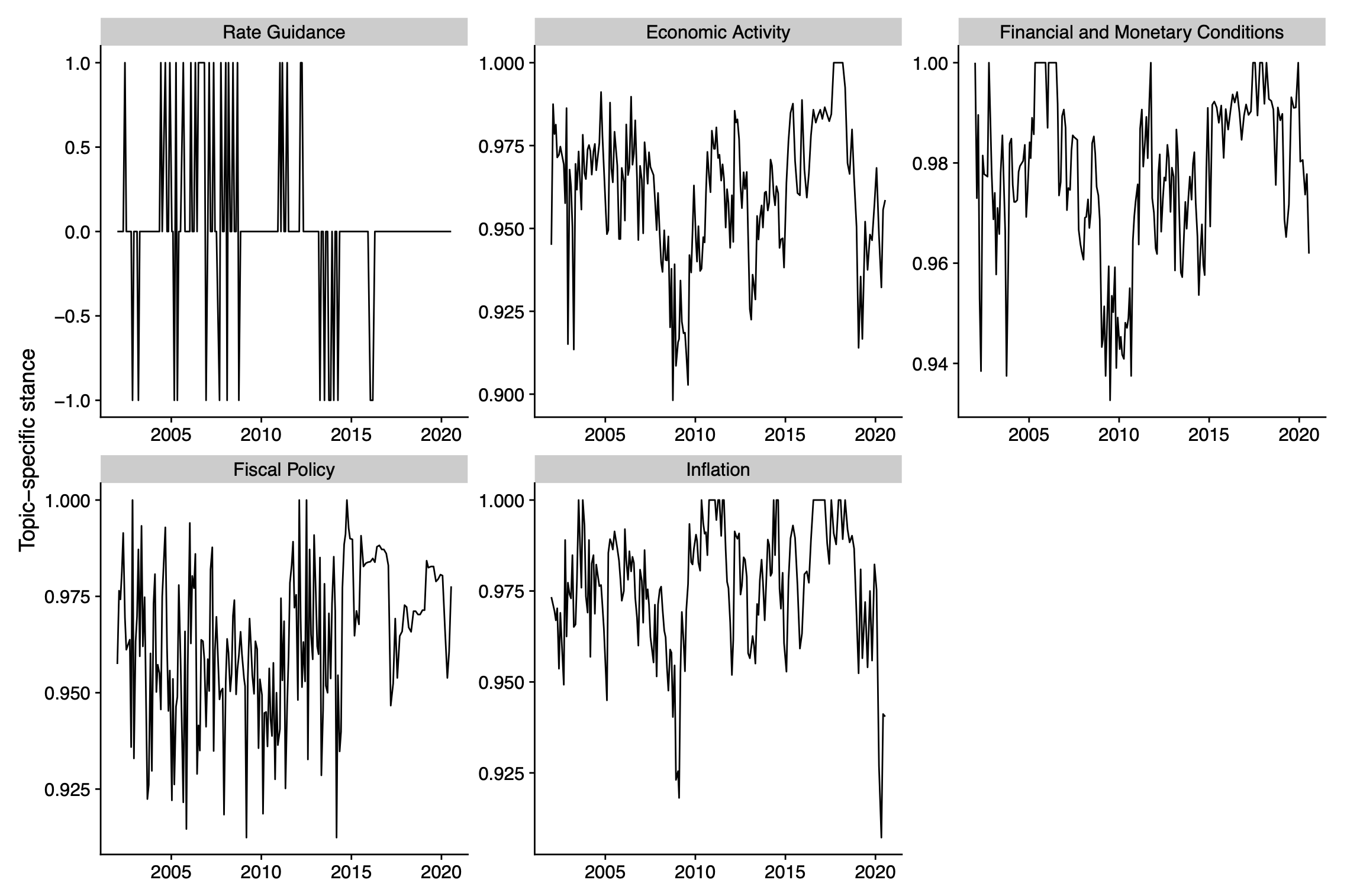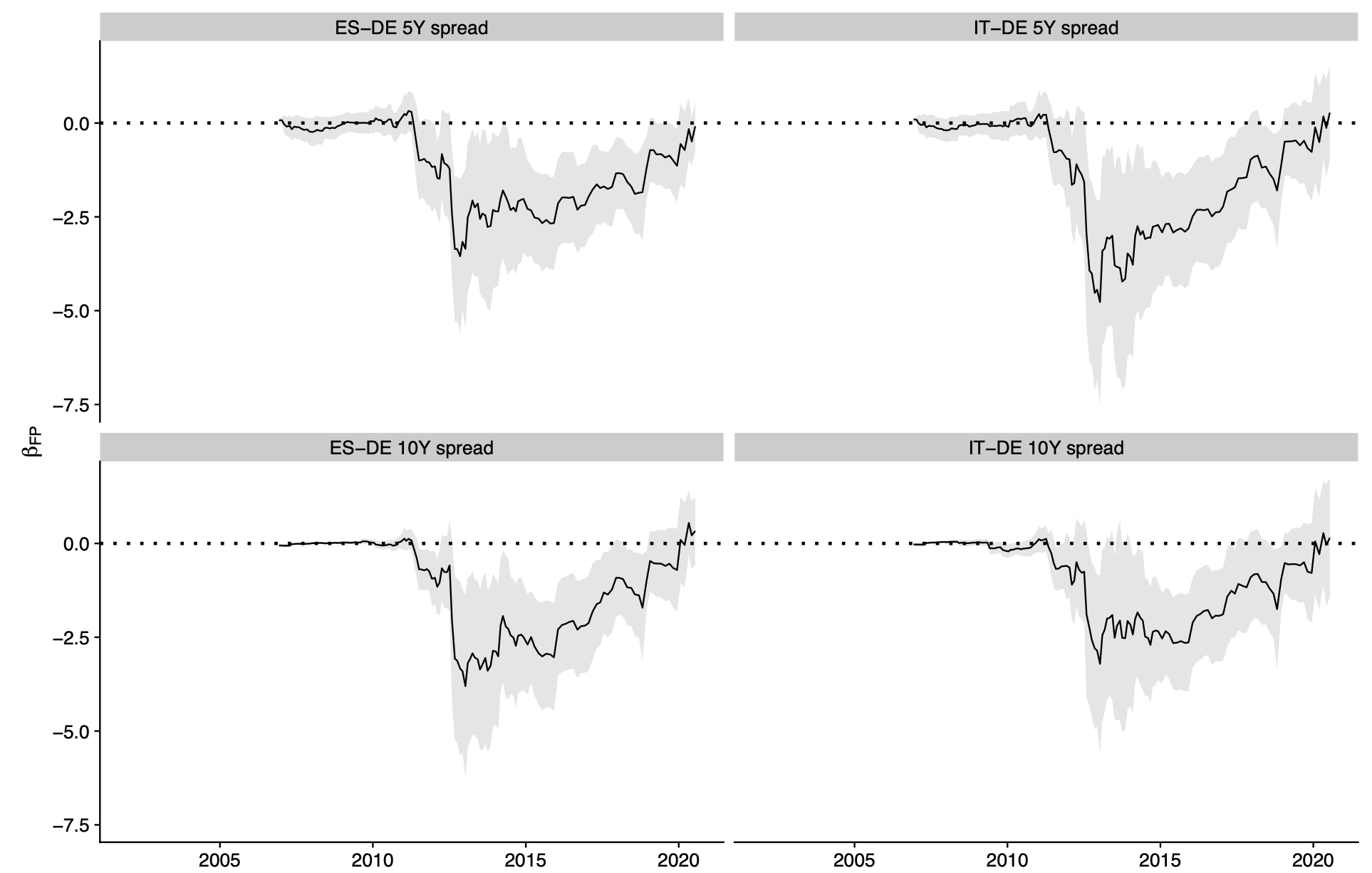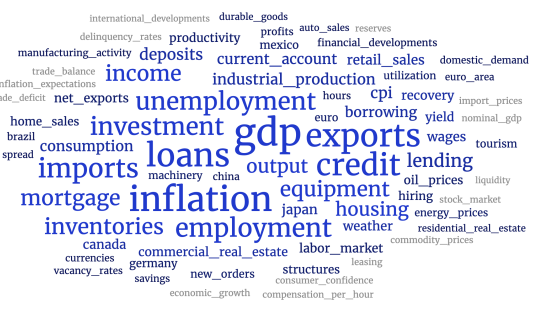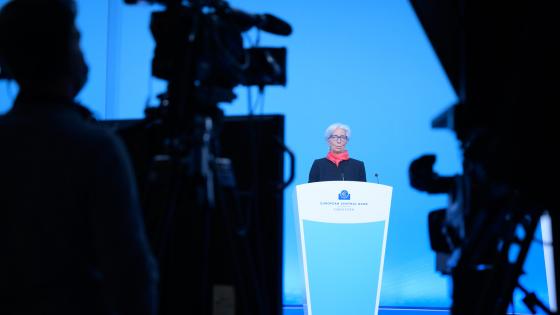A standard approach to assessing monetary policy shocks is to measure high-frequency market price reactions around central bank announcements (e.g. Nakamura and Steinsson 2018). Economic theory then serves to give these price-based shocks an economic interpretation. For example, researchers would infer the news embedded in a monetary policy announcement by comparing the level of two-year interest rates shortly before and shortly after the announcement. If rates increased, the announcement is interpreted to have revealed news that led to an upward shift in expectations about the path of future short rates (see, for example, Bauer and Swanson 2022 for an overview of this literature).
In a recent paper (Gnan et al. 2022), we propose to identify monetary policy shocks directly from the contents of central banks' verbal communication with the public. Put differently, instead of inferring an economic interpretation indirectly from asset price movements, we connect market responses directly to what a central bank actually says.
Extracting news from central bank communication
In our empirical analysis, we study the ECB, which has applied a consistent communication strategy since its inception. The ECB announces policy decisions after Governing Council meetings and holds a press conference 45 minutes later. The press conference starts with a pre-scripted statement by the ECB president to explain the policy decision and to elaborate on the economic outlook. This statement contains discussions on five topics: rate guidance, economic activity, inflation, financial & monetary conditions, and fiscal policy.
Using textual analysis, we measure the ECB’s stance towards each of these topics for press conferences between January 2002 and July 2020. For rate guidance, we use a manual classification to distinguish indications of easing (-1), unchanged policy (0), and tightening (1). To quantify stances on the other topics, we measure the ECB’s tone by assessing the prevalence of negative words in the topic discussions and construct stance measures such that a higher value implies a more positive tone. Figure 1 shows that the resulting topic-specific measures of ECB stance align well with major macroeconomic events and turning points in the euro area.
Figure 1 Topic-specific ECB stances
To assess the actual news embedded in the ECB’s statement, we use changes in the topic-specific stances compared to the previous press conference while controlling for the public’s information set prior to the statement using a broad range of financial, economic, and policy (communication) variables.
Central bank news and asset prices
We start by examining the impact of changes in the ECB’s topic-specific stances on risk-free interest rates across the entire term structure, core–periphery sovereign yield spreads, and euro exchange rates.1 Figure 2 shows how asset prices respond to topic-specific news in short windows around ECB press conferences. We plot price sensitivities that are significant at least at the 10% level, with darker shading indicating a higher level of significance.
Figure 2 Sensitivities of asset prices to news communicated by the ECB
ECB communication about rate guidance on future interest rates mostly affects short-term OIS rates such that hawkish news is associated with higher 3-month and 2-year rates. More positive communication about economic activity mostly matters for 2-year rates, whereas news about financial & monetary conditions moves rates at the long end of the yield curve (10-year). Financial & monetary conditions also have a strong effect on euro exchange rates in that good news are associated with an appreciation of the euro against the dollar, pound, and yen. This finding is consistent with recent research on the role of financial intermediaries in currency markets (e.g. Gabaix and Maggiori 2018). Moreover, we show that a more positive ECB communication about fiscal policy significantly reduces yield spreads of Spanish and Italian versus German government bonds. Finally, we find that any news about inflation is subsumed by communication about other topics during our sample period.
It is important to note that market responses to topic-specific news can change over time. Figure 3 illustrates such time-variation for fiscal policy news, which shows a particularly strong response in sovereign spreads during the European debt crisis (e.g. Mueller et al. 2017). In light of the current rise in sovereign spreads, this finding suggests that communication about fiscal policy may be an effective instrument during crisis times.
Figure 3 Sensitivities of sovereign spreads to the fiscal policy news
Notes: At a given point in time, sensitivities are estimated from the previous 60 press conferences.
Monetary policy shocks through the lens of central bank communication
Our text-based, topic-specific news measures also allow for a validation of the economic interpretations associated with price-based measures of monetary policy shocks (see Arouba and Drechsel 2022 for an example of an alternative approach based on CB communication). The recent literature has proposed a range of such shock measures based on the joint responses of interest rates with different maturities and/or stock prices. Figure 4 summarises how three sets of shock measures suggested by previous research can be connected to the topic-specific news that we identify from ECB statements.
Figure 4 Sensitivities of monetary policy shocks to news communicated by the ECB
We start with shocks to the term structure of interest rates, characterised in terms of the three factors suggested by Altavilla et al. (2019): a timing factor (which reflects short-term yields), forward guidance (the middle of the yield curve), and a quantitative easing (QE) factor (long-term yields). Corroborating the interpretations in Altavilla et al. (2019), we find that their timing factor is driven by news about rate guidance, their forward guidance factor is significantly related to news about economic activity, whereas their QE factor is mostly driven by news about financial conditions.
Next, we study shocks identified from the joint response in interest rates and stock prices, which previous research has used to distinguish price effects due to changes in monetary policy from effects due to other information revealed by central banks (e.g. Nakamura and Steinsson 2018, Miranda-Agrippino and Ricco 2021, Jarociński and Karadi 2018, Cieslak and Schrimpf 2018). The intuition for distinguishing policy shocks from information shocks via sign restrictions on interest rates and stock returns is as follows. Suppose a central bank announcement is accompanied by an unexpected increase in interest rates. In case of a policy shock, one should observe that stock prices decrease, due to higher discount rates. By contrast, in case of an information shock from unexpectedly good news about the economy, one should observe an increase in stock prices as well, due to higher cash-flow expectations. Our text-based ECB news measures allow us to verify such price-based interpretations, and we do so for two sets of shock measures.
First, we identify policy and information shocks as proposed by Jarociński and Karadi (2018). Our findings suggest that the price-based interpretations are consistent with the actual news communicated by the ECB: policy shocks load significantly on news about rate guidance, whereas information shocks are significantly related to news about economic activity (but not to news about rate guidance). Hence, our results support the notion of policy vis-a-vis information shocks as distinct dimensions of news communicated by the ECB.
Second, we follow Cieslak and Schrimpf (2018), who consider monetary and growth shocks, which are similar to the shocks of Jarociński and Karadi (2018), and additionally risk premium shocks; the additional structure in their identification arises from using short- and long-term interest rates. In line with their interpretations, we find that monetary shocks are closely related to news about rate guidance, growth shocks are most closely related to economic activity, and that risk premium shocks are significantly affected by news about financial conditions. The last result is, again, consistent with the role of intermediaries for asset prices.
Implications
Our findings show that news directly extracted from the ECB’s press conference statements can be useful for understanding how market prices of different assets respond to central bank announcements. Using our text-based approach avoids having to rely on indirect interpretations that are common in the literature on monetary policy shocks; instead, the economic rationale stems directly from the central bank’s communication.
By fine-tuning their topic-specific communication, central banks can affect different segments of financial markets in different ways, which should be particularly useful in turbulent times. The time-varying nature of communication effects suggests that market participants are concerned with different topics at different times, and it is conceivable that inflation communication may become more important in the current macroeconomic environment.
References
Altavilla, C, L Brugnolini, R S Gürkaynak, R Motto and G Ragusa (2019), “Measuring euro area monetary policy”, Journal of Monetary Economics 108: 162-179.
Auroba, B and T Drechsel (2022), “Identifying monetary policy shocks: A natural language approach”, VoxEU.org, 17 May.
Bauer, M D and E T Swanson (2022), “A Reassessment of Monetary Policy Surprises and High-Frequency Identification”, CEPR Discussion Paper No. 17116.
Cieslak, A and A Schrimpf (2018), “Monetary and non-monetary news in central bank communication”, VoxEU.org, 22 0ctober.
Ehrmann, M, S Holton, D Kedan and G Phelan (2022), “Views on monetary policy communication by former ECB policymakers”, VoxEU.org 17 January 2022.
Gabaix, X and M Maggiori (2015), “International liquidity and exchange rate dynamics”, The Quarterly Journal of Economics 130(3): 1369-1420.
Gnan, P, M Schleritzko, M Schmeling and C Wagner (2022), “Deciphering Monetary Policy Shocks”, CEPR Discussion Paper No. 17295.
Jarocinski, M and P Karadi (2018), “The transmission of policy and economic news in the announcements of the US Federal Reserve”, VoxEU.org, 3 October.
Miranda-Agrippino, S and G Ricco (2021), “The transmission of monetary policy shocks”, American Economic Journal: Macroeconomics 13(3): 74-107.
Mueller, P, A Tahbaz‐Salehi and A Vedolin (2017), “Exchange rates and monetary policy uncertainty”, The Journal of Finance 72(3): 1213-1252.
Nakamura, E and J Steinsson (2018), “High-frequency identification of monetary non-neutrality: the information effect”, The Quarterly Journal of Economics 133(3): 1283-1330.
Endnotes
1 All data are from the European Area Monetary Policy Database (EA-MPD) (see Altavilla et al. 2019).











